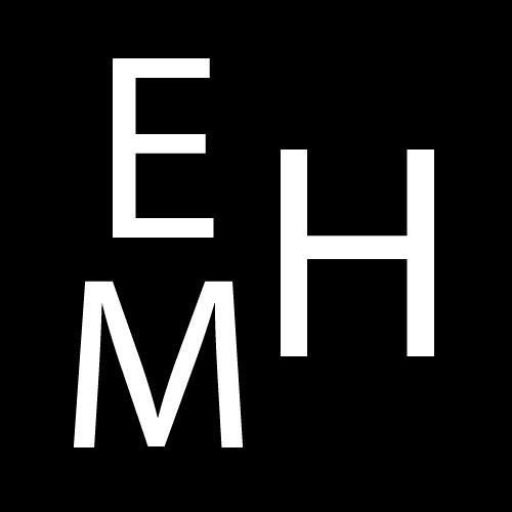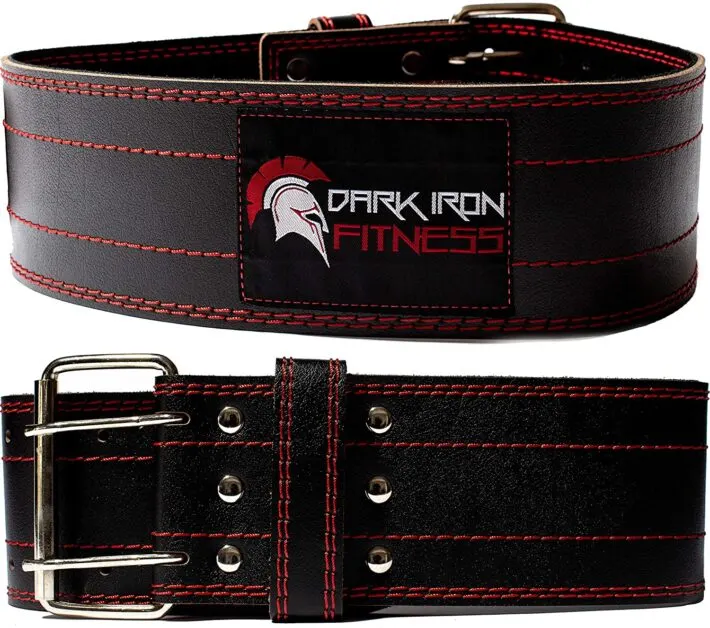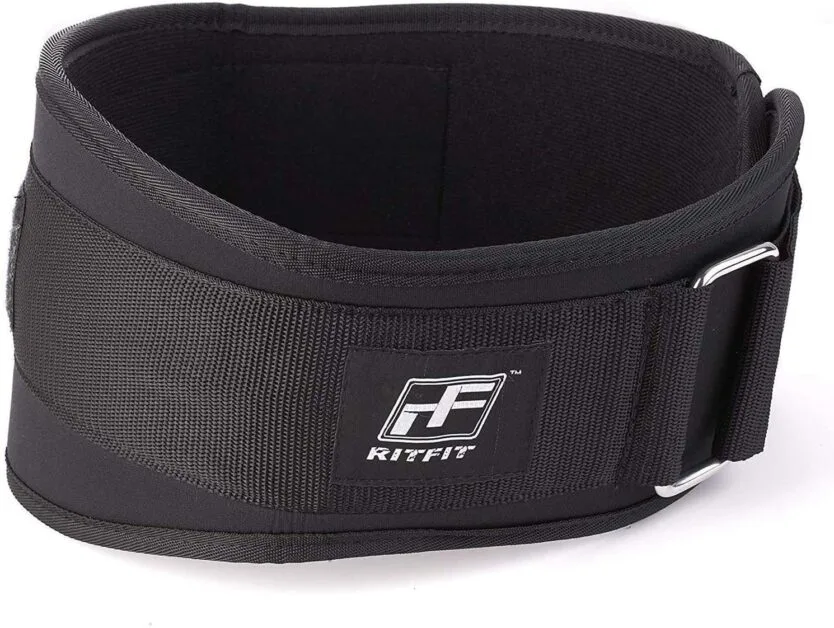Some of the links in this post are affiliate links. This means if you click on the link and purchase the item, we will receive an affiliate commission from the vendor at no extra cost to you. These business relationships allow us to keep bringing you great EatMoveHack content. All opinions remain our own.
If you’re not already using a weightlifting belt, you’re missing out on a world of support and safety. Designed to reinforce your back and increase the pressure in your abdominal cavity, these gym belts help you lift more weight, all while preventing injury.
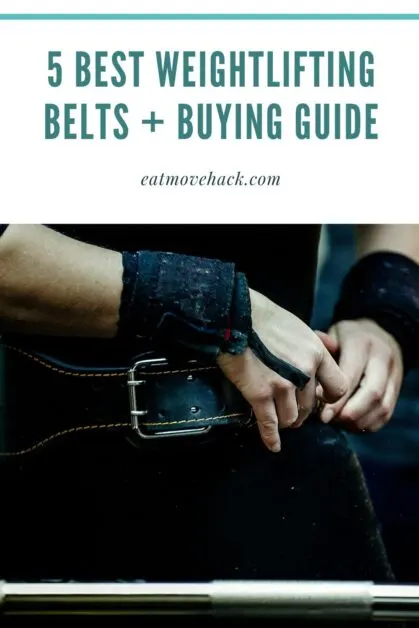
Because we know you’re busy getting in more reps, we did the hard job of reviewing dozens of popular brands and styles to find the best weightlifting belts for a variety of needs. Whether you’re into powerlifting or body weight training, we’ve found options to help you improve your gym game.
Of all the lifting belts we tested, we liked the Dark Iron Fitness Weightlifting Belt the most. It’s a smart choice for beginner and immediate users because it’s not too thick, but it still offers loads of support and comfort. Learn more about it and our other picks below, and then keep going for info on what you need to know when picking out this important gym accessory.
DMoose Fitness Dip Belt with Chain – https://www.amazon.com/DMoose-Fitness-Premium-Belt-Chain/dp/B01N5PB7CZ
FlexzFitness Leather Powerlifting Belt –
https://www.amazon.com/Flexz-Fitness-Buckle-Powerlifting-Lifting/dp/B01BLHCMJW
AAYLANS 13 MM Lever Belt – https://www.amazon.com/AALYANZ-Lever-Leather-Support-Weightlifting/dp/B08FJ3MC8L
1. Dark Iron Fitness Weightlifting Belt – Best Weightlifting Belt for Beginners
Entry-level gym belt that’s comfortable and supportive
Measuring 4 mm thick and made from 100% buffalo hide, the Dark Iron Fitness Weightlifting Belt is a great choice for those who are just starting their weightlifting programs. It’s not as thick (or expensive) as more premium models, but it still provides tons of support for your back and core.
Like most leather weightlifting belts, we found this one to be rather stiff out of the box. But because it’s thinner than most (4 mm vs the industry-standard minimum of 6.5 mm), it also became more flexible and supple in less time. By our fifth or sixth workout, we noticed that the belt wasn’t digging into our ribs at all.
Even though it’s thinner than most belts, it’s just as wide at 4 inches. This means that it sits nicely on the body and provides support where necessary. When we deadlifted, we felt the welcome support at our lower back.
This lifting belt features a double buckle. It’s a benefit because it spreads the pressure of the closure across a greater area, but that also makes it somewhat more difficult to put on and take off, depending on how tightly you secure it. When we tightened the belt further than four belt holes, we definitely had to give an extra tug to get it off.
If you’re a competitor lifter, you’ll be happy to know that this gym belt is USAPL approved. It’s rated for 600 lbs, so beginners and beyond will definitely get a lot of use out of it before needing to upgrade. Of course, don’t expect to don this belt and suddenly be able to lift the max. (We know some beginners are eager!) Instead, you can expect about 10% gains.
The only big negative we could find about the lifting belt is that the manufacturer’s sizing structure is a bit confusing. It overlaps on sizing, so if you find yourself at the end of one spectrum and the beginning of the other, you’ll most likely be tempted to go with the larger size. Unfortunately, this will result in a belt that’s much too long. When in doubt, we say: go smaller.
What I Liked
- High-quality buffalo hide is tough and will clearly last
- Thinner belt breaks in more quickly for better comfort
- USAPL approved for competitions
What I Didn’t Like
- Double buckle can be difficult to undo after a workout
- Sizing can be confusing — have to go smaller for the right fit
2. RitFit Weightlifting Belt – Best Weightlifting Belt for Lightweight Lifting
Simple lifting belt for those who don’t go hard at the gym
Because it’s made from synthetic materials and is stretchier than those made from leather, this RitFit weightlifting belt is ideal for lightweight lifters who don’t need tons of support. As a matter of fact, this lifting belt offered just the right amount of support, we found ourselves reaching for it as a back brace even when outside the gym.
Unlike most leather lifting belts, this synthetic one relies on a hook-and-loop closure. Just slip the strap through the roller and pull as tightly as you’d like to fasten it. Unlike a buckle closure, there are no belt holes to aim for, so the belt is super easy to put on. But at the same time, you don’t get the same reinforcement, so you have to be sure there’s enough grip on the hook-and-loop materials when you attach them or you risk popping the belt off when you lift.
The gym belt is six inches wide, so you’ll notice lots of coverage for deadlifts, squats, lunges, and more. We enjoyed lots of lumbar support during our workouts, and we didn’t experience any discomfort due to the wider size. As the belt’s material is softer, there was also no need for a break-in period to keep it from chafing.
Despite not providing as much support, this lifting belt is definitely more versatile than those made from leather. You can wear it throughout your workout, even through cardio. If you get sweaty, don’t worry about ruining your lifting belt. It’s made with a waterproof core, and you can hand wash it if necessary.
There’s no overlap when it comes to this belt’s sizing, so if you find yourself just about between sizes, we would suggest you go up to ensure that you’ve got plenty of room to close the belt securely. The belt is available up to size XXL, so it fits waists up to 59 inches — it’s definitely more accommodating than most!
What I Liked
- Soft, airy material that’s perfect for lightweight lifting
- Easily doubles as a back brace for extra support outside the gym
- Available in sizes to accommodate waists from 22 to 59 inches
What I Didn’t Like
- Hook-and-loop closure method isn’t as secure as traditional buckle
- Complaints of belt stretching out after excessive use
3. AAYLANS 13 MM Lever Belt – Best Weightlifting Belt for Powerlifting
Super supportive weightlifting belt for preventing injury
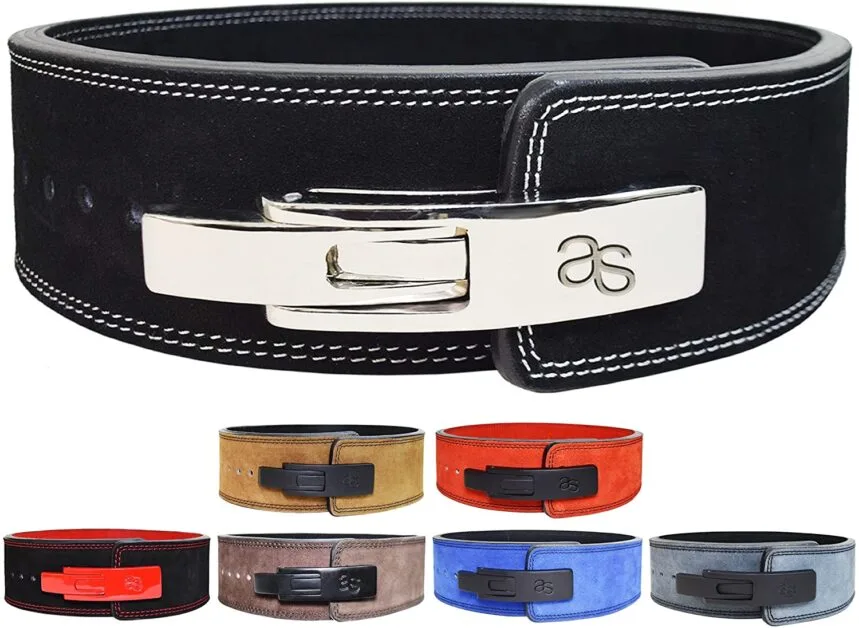
If you like to go hard at the gym, the AAYLANS Lever Belt is sure to be a supportive companion. The belt measures 13 mm thick and is made from cowhide, so you won’t find a thicker, more heavy-duty lifting belt for squats, deadlifts, and more.
It’s the combo of material and thickness that make this belt such a formidable choice. It’s held together with super-durable nylon stitching and made to IPF specs, so it will stand up to your heaviest lifts without failing. A buddy of ours used the gym belt during a 400 lb deadlift and gave it a big thumbs up.
As expected due to its material, this lifting belt was really stiff the first time we used it. Despite careful placement, we still found ourselves with a light band of bruises around our midsection. We’ve been using it twice a week for the last two months, and it’s still pretty rough, but we can definitely feel it loosening up.
This belt features a lever closure. This means you decide on a belt hole, and screw the lever mechanism in place. When you’re ready to put on the belt, you just pull the lever closed, and you’re ready to go. This is highly convenient for quickly getting the belt on and off, but it’s a hassle when you need the belt looser or tighter as you have to pull out a screwdriver to adjust the mechanism.
There’s a little bit of crossover when it comes to sizing. For example, if you’ve got a 34-inch waist, you could fit into a medium or large. However, 34 inches is the max waist for the medium, so it’s an easy choice to go with the large. Other sizes are similarly easy to figure out.
What I Liked
- Heavy-duty and hugely supportive gym belt for powerlifting
- Variety of bold colors from which to choose
- Easy, consistent sizing for finding the perfect fit
What I Didn’t Like
- Super stiff and takes a while to break in
- Lever positioning can only be changed with a screwdriver
DMoose Fitness Dip Belt with Chain – Best Weightlifting Belt for Dips and Pullups
Pullup and squat belt for increasing resistance
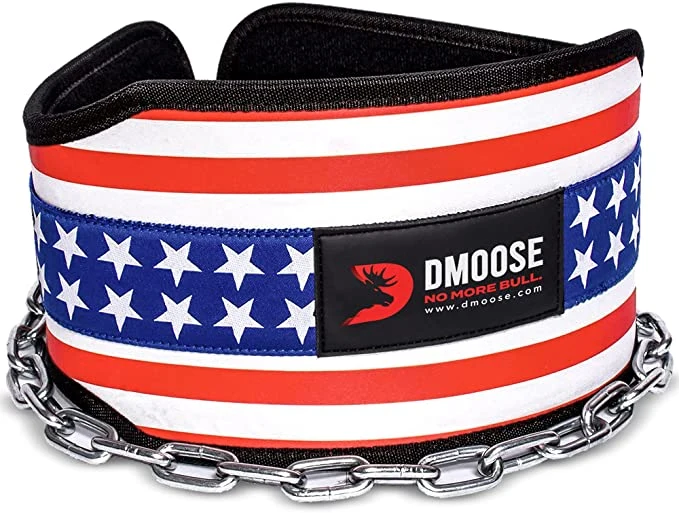
The DMoose Fitness Belt differs from the other products on our list, but it’s still one of the best weightlifting belts for those who are looking to build muscle and strength through dips, pullups, and other weight training routines.
If you’re not familiar with this type of belt, the first thing you need to know is that it doesn’t provide any type of lumbar or abdominal support. Instead, you use the lifting belt to attach weights, increasing the difficulty of various body weight exercises.
You attach weight via a 36-inch, heavy-duty chain. Just unclip one side of the chain, slide a barbell weight or kettlebell through, and reattach before getting to work. Reinforced stitching ensures the belt won’t let you down, while the positioning of the chain keeps the extra weight in front of you and out of the way.
The manufacturer says the chain can support weights up to 225 lbs. We haven’t tried the max yet, but we’ve gone up to 100 lbs with this squat belt, and it did fine there. If we were going to go higher, we’d change out the carabiner clips first as they don’t seem sturdy enough to handle more weight.
As far as comfort, we don’t have anything to complain about. The lifting belt is made of heavy-duty neoprene, so it’s lightweight and breathable. It sits comfortably at the hips, and it doesn’t move around or shift. While the manufacturer doesn’t say anything about washability, we gave it a quick bath after a hard exercise session, and it air dried with no issues.
We know that the belt’s looks have no impact on its performance, but we did like that you have more options than just black. Along with blue, grey, and camo, you can also choose an American flag motif that actually looks really stylish.
What I Liked
- Comfortable dip, pullup, and squat belt for body weight training
- Chain and stitching look like they’ll hold up for a long time
- Lightweight, breathable, and hand washable
What I Didn’t Like
- Carabiners aren’t the best quality and should be changed out for heavier weights
- Universal sizing may not comfortably fit those with smaller waists
5. FlexzFitness Leather Powerlifting Belt – Best Weightlifting Belt for Speedy Use
Weightlifting belt with quick closure for hassle-free wear
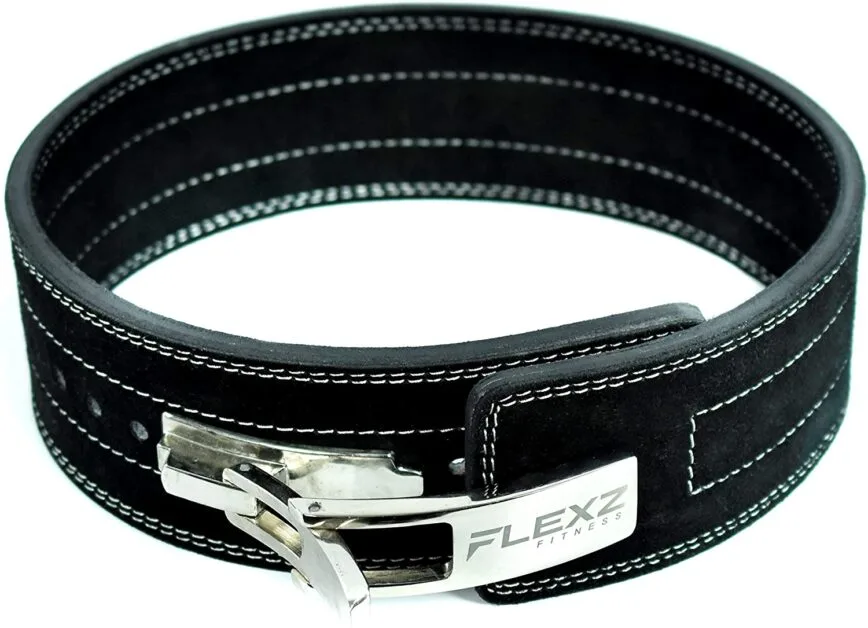
Of all the lever-closure belts we reviewed, we liked the FlexzFitness Leather Powerlifting Belt best. The lever has the smoothest action of those we tried, and the belt itself offers a nice 10 mm thickness for intense workouts.
If you prefer to wear your belt at the same size most of the time, a lever closure is a no-brainer. Why bother with yanking on a buckle when you can just pull a handle? During our workout, we were able to get this lifting belt on in just seconds. We know it’s not a race, but we really liked not having to tug and pull!
Of course, with a lever belt, you can’t change sizes at will — instead, you need a screwdriver to make the adjustment. But again, if you don’t tend to change things up much, this won’t be an issue.
We will say that some other users did have a big problem with the lever: after several months or years of use, a pin may work itself loose and render the closure useless. This is a huge inconvenience, but the good news is the manufacturer is on top of things and will send you a replacement when you reach out.
Because the belt isn’t super thick, it breaks in more quickly. It wasn’t that uncomfortable at the start, but it definitely hit its stride around the one-month mark. Its newfound flexibility really makes it more comfortable, especially during heavier lifts.
This weightlifting belt is IPF and USAPL compliant, so if you’re into competitions, you can take it with you. The belt is available in several color choices, including red, blue, purple, and pink, and as required, there is no visible logo.
The manufacturer says the lifting belt is rated at over 850 lbs. Of course, we couldn’t hit anything close to that, but a friend used it for a 405 lb lift, and he thought it did a great job and could easily handle more.
What I Liked
- Smooth-moving lever closure makes for quick use
- 10 mm belt softens after repeated use for greater comfort
- IPF and USAPL compliant for competitive use
What I Didn’t Like
- Made from artificial leather rather than genuine hide
- Lever may fail after excessive use
What We Looked For in the Best Weightlifting Belts
Lifting belts play an important role in keeping you safe at the gym. For that reason, you have to be particular when picking one out — you’re not going to trust your health and wellbeing to just any product, right? We aren’t either, which is why we considered important criteria while reviewing the best weightlifting belts.
- Quality — A belt has to be sturdy and well-made in order to provide the support and comfort you need to stay safe and lift more weight.
- Support — Every weightlifter needs something different, so we looked for good belts that offered varying degrees of support.
- Sizing — A weightlifting belt is useless if it doesn’t fit, so we looked for those with easy-to-understand sizing so you can make the right choice.
How to Choose the Right Weightlifting Belt
We think the Dark Iron Fitness Weightlifting Belt is the perfect choice for beginner to intermediate lifters who want to increase their ability while staying safe. But maybe you need something different because you prefer weight training or are more advanced. Below are the most important factors to consider when shopping for the best weightlifting belt.
Type
The most common types of weightlifting belts are bodybuilding, dipping, and powerlifting. You’ll typically choose one depending on the types of exercises you do, but in the case of bodybuilding and powerlifting, you may be able to use them interchangeably for some workouts. At the end of the day, don’t focus too much on a label; instead, look at what the lifting belt provides to make sure it meshes with your needs.
Material
Weightlifting belts are generally made from leather, synthetic leather, or other synthetic materials, such as neoprene. Generally, leather belts are the most heavy-duty, suitable for powerlifting and other intense routines because they provide the greatest support. Neoprene and other fabric belts don’t provide as much support, so they’re more appropriate for lightweight lifting.
Closure
Lifting belts may feature one of four closure types:
- Buckle — Similar to a traditional belt, this style features a single clasp that’s inserted into one of several belt holes
- Double buckle — Single-buckle and double-buckle closures work exactly the same, except the latter has two clasps rather than one
- Hook-and-loop — Commonly referred to as velcro, this type of closure features two materials that stick to each other when pressed together
- Lever — Metal or plastic closure made up of a handle that you slide closed
Choosing a closure type is mostly personal preference, though it’s important to understand the pros and cons of each before making a decision. For example, a double buckle may offer more support, but it can be extremely difficult to attach and remove the belt if you prefer a tight fit. Hook-and-loop closures are easy and convenient, but they may separate during especially heavy lifts. Levers are even more convenient, but moving from one size to another requires a screwdriver.
Size
Choosing the right size weightlifting belt is vital to its proper function. If you choose one that’s too small, it may be uncomfortable or even unsafe (specifically, hook-and-loop closures that may suddenly come apart or clasps that prevent you from taking a full breath). On the other hand, choose one that’s too large, and you may have a ton of excess material that also makes the gym belt uncomfortable to wear.
When taking measurements for a lifting belt, you should stand tall and wear your typical workout clothing. Use a flexible tape measure around your midsection where the belt will sit (generally around your belly button). Don’t tense your abdomen, suck in a breath, or use your pant’s size as you won’t get an accurate measurement.
Wrapping Up
Material, closure method, and size make the biggest impacts on how much a lifting belt will benefit you. Choose carefully depending on your gym activities and personal needs, and you’ll enjoy incredible support when pumping iron.
We think that the Dark Iron Fitness Weightlifting Belt is the best weightlifting belt for beginners, occasional lifters, and intermediate users who are not quite ready for something more heavy-duty. It’s well-made, affordable, and versatile, so you’ll get plenty of use out of it.
Need help figuring out the right diet to supplement your bodybuilding workouts? We’ve got a simple nutrition plan for building muscle that offers lots of tips.
